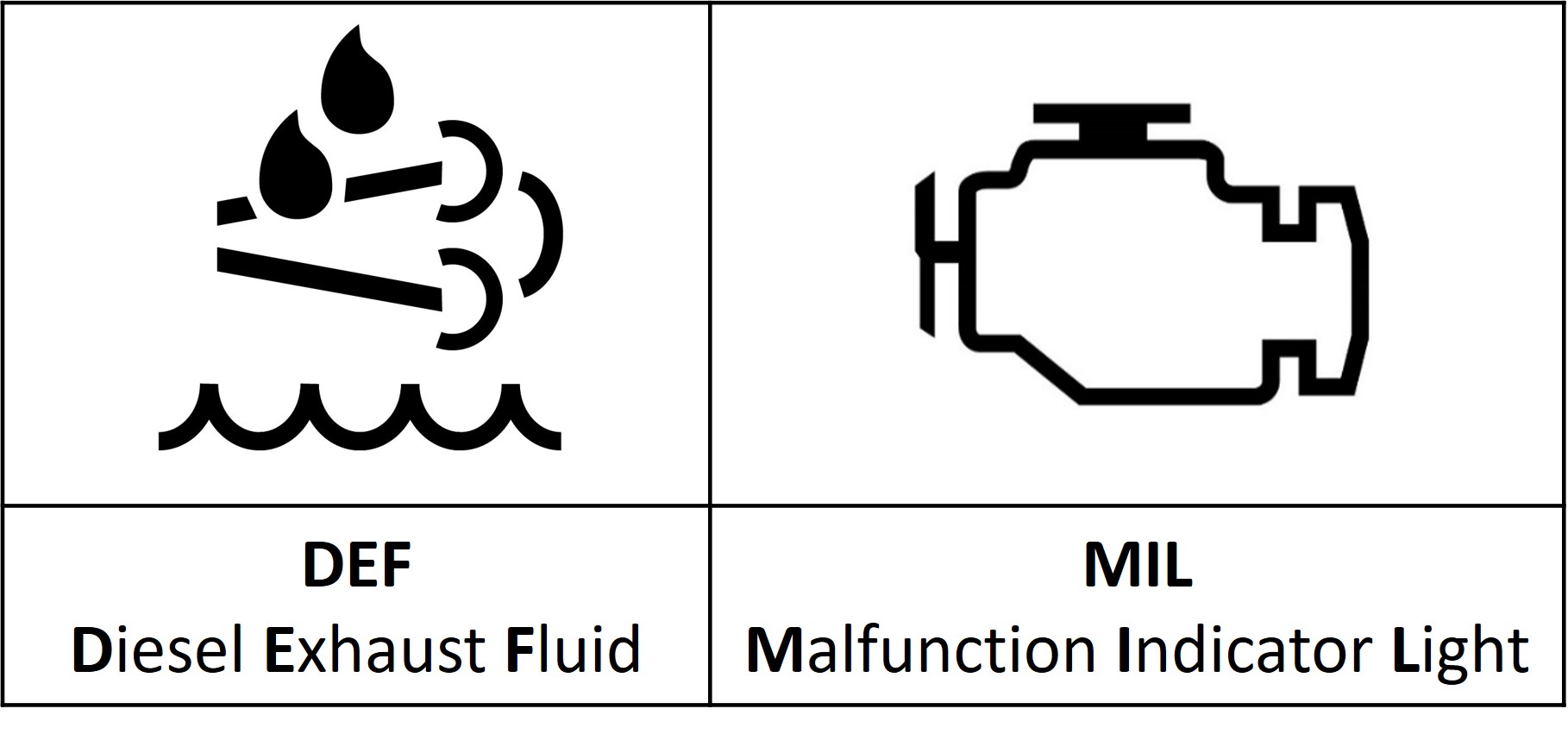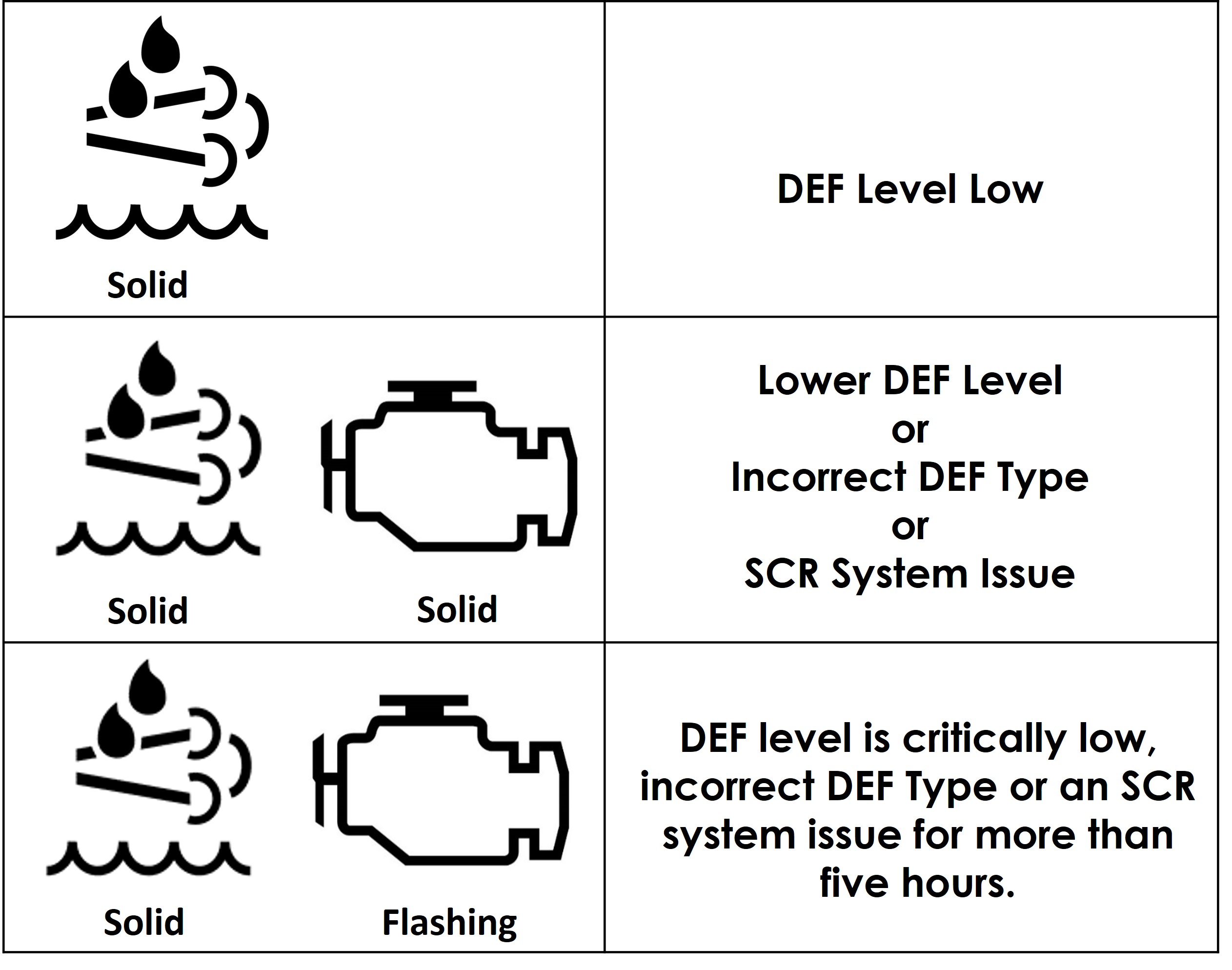Introduction
Diesel engines beginning in 2010 include emissions equipment that requires the addition of Diesel Exhaust Fluid (DEF). The system was required to measure the quantity and temperature of DEF in the tank and give warnings when level or temperature was beyond acceptable levels. Beginning in 2016 the emissions system was also required to measure the quality of the DEF in the tank. This is a more difficult technology to implement, and the trucking industry struggled to find DEF quality sensors that were accurate and reliable. This FAMA guidance document is intended to provide fire departments and fire apparatus service personnel information on the impact of DEF sensor reliability and guidance on how to keep apparatus in service.
Contents
Diesel Exhaust Fluid Facts
Selective Catalytic Reduction Requires DEF
Fire apparatus manufacturers have been challenged with adapting to new engine emissions regulations every three to five years since 1991. These regulations took a major step in 2010 when Environmental Protection Agency (EPA) emissions regulations forced a significant reduction in oxides of nitrogen (NOx). To achieve these much lower NOx levels, diesel engine manufacturers had to choose between a technology that would significantly increase exhaust gas recirculation (EGR) flow or one that used selective catalytic reduction (SCR). Most engine manufacturers worldwide chose the SCR route because it provided the NOx reduction without sacrificing fuel economy. SCR equipped vehicles require a tank of Diesel Exhaust Fluid (DEF) to make the system work.
What is DEF
DEF is a colorless, odorless, nontoxic, nonflammable, injectable fluid used in SCR diesel engine exhaust systems to reduce regulated exhaust emissions. It is a mixture of 32.5 percent urea and distilled water. While DEF is not toxic, it is corrosive to metal components. Should it be spilled while filling the vehicle tank, the affected metal components should be rinsed with water. ISO Standard 22241-1 defines the characteristics of approved DEF fluid. When purchasing DEF, look for this ISO standard or the “API classified” symbol.
What Does DEF Do?
While the engine is running, an electronically controlled injection of DEF is made into the exhaust system downstream of the diesel particulate filter (DPF) and upstream of the SCR catalyst. The DEF is converted to ammonia, which reacts with the NOx from the engine exhaust in the SCR catalyst. The resulting tailpipe emissions are nitrogen, carbon dioxide, and water. While the need to add DEF adds an extra step, SCR technology does improve fuel economy, increases the intervals between maintenance events, and enhances engine performance.
Operating Def-Equipped Vehicles
Because DEF injection is required to maintain the appropriate levels of NOx emissions, the DEF system is part of on-board diagnostic (OBD) requirements. Sensors ensure the proper DEF temperature, DEF concentration, and DEF level. Most vehicles include a DEF level gage (similar to the fuel-level gage) on the dash. A lamp indicates when levels are low.
Because operating a vehicle without DEF or with improper DEF level concentration can result in increased emissions, the EPA requires that a lamp on the dash be illuminated to indicate these situations. For non-emergency vehicles, these conditions can reduce engine performance, including derated horsepower and torque. In fact, if the DEF tank is empty and the vehicle idles for more than one hour, the operator adds fuel without adding DEF, or the key switch is turned off, non-emergency vehicles will be limited to a maximum speed of five miles per hour.
These derate requirements were initially proposed by the EPA for emergency vehicles as well. However, through the efforts of the Fire Apparatus Manufacturers Association (FAMA), the International Association of Fire Chiefs (IAFC), and engine manufacturers, emergency vehicles were granted a “derate exemption.”
The EPA derate exemption means that the engine manufacturers do not need to program the derate into the engine programming. Special emergency vehicle programming ensures that they will not experience engine horsepower, torque, or speed derates because of DEF quality, temperature, or level. Even so, departments should not continue to operate without DEF because it can cause DEF-cooled components, like the DEF injector, to fail.
Should the DEF lamp and the Malfunction Indicator Lamp (MIL) light up at the same time, this could indicate a DEF sensor failure. The vehicle should be inspected or repaired by a qualified technician.


MIL or Check Engine Light
Illuminates YELLOW when the Heavy-Duty On-Board Diagnostics (HD-OBD) system detects a malfunction related to the emissions control system. The illuminated MIL indicates the vehicle needs to be serviced at the first convenient opportunity.
Maintaining DEF-Equipped Vehicles
The most important aspect of maintaining DEF equipped vehicles is to use quality DEF and keep the DEF above the minimum level. It is recommended that operators top off the DEF tank when they refuel the vehicle. This reduces the chance that low DEF levels will create bubbles that might result in DEF concentration faults.
DEF Filter
The SCR system includes a DEF filter. For most DEF-equipped vehicles, this filter requires maintenance only if contaminants are in the DEF or if the vehicle reaches 300,000 miles. Most emergency vehicles do not reach this mileage limitation, so make sure you use good quality DEF to avoid filter plugging.
Faulty DEF Sensor Issue
If your apparatus was manufactured with a 2010 model year or later emissions system and you are required to add Diesel Emissions Fluid (DEF), then your system will include a sensor that detects the level, temperature and/or quality of the DEF in the tank (DEF Sensor). The heavy truck industry in general, and the fire industry specifically, has been working with DEF sensor suppliers to obtain the most reliable DEF sensors. The global chip shortage has made the situation worse.
The reliability problem has several aspects, and the sensor manufacturers have been attempting to improve their designs. Field replacement parts needs, increased production, and supplier production delays have created a shortage of sensors particularly for service needs.
EPA/CARB DEF Sensor Relief
The Environmental Protection Agency (EPA) and the California Air Resources Board (CARB) have recognized the DEF sensor reliability and shortage issues. They understand the importance of keeping automotive vehicles in service and have therefore granted the industry permission to run engines without functioning DEF sensors until the DEF sensor shortage can be rectified.
If your apparatus has been diagnosed by a service facility with a faulty DEF sensor, and you are not able to obtain a replacement, you can keep the apparatus in service by following these guidelines.
1) Stay in Service -
A defective DEF sensor will cause the DEF indicator lamp and the MIL lamp to illuminate. Both of these lamps are indicating an issue with the emissions system. While any emissions issue should be corrected as soon as possible, an emissions issue will not cause immediate engine derate, engine harm or operational failure. You may choose to keep the apparatus in service while you wait for a replacement DEF sensor to become available. DEF should be refilled each time the apparatus is refueled.
2) Monitor Fault Codes
The MIL lamp could illuminate from many different emissions system failures, not just a bad DEF Sensor. For this reason, it is important to regularly monitor the fault codes to ensure that you do not have other vehicle issues in addition to the faulty DEF sensor. Depending on your apparatus design fault codes may be displayed on a vehicle information screen, or they can be obtained using an inexpensive fault reader available at any auto parts store.
DEF Sensors by Engine Emissions Date Range
Model Year 2009 and earlier
These engines are not equipped with SCR emissions hardware and will not have a DEF Sensor.
Model Year 2010-2015 Engines
DEF systems for model year 2010 through 2015 used analog components that sensed DEF level and temperature only. These DEF sensors have a much lower failure rate and are not typically an issue to replace.
Model Year 2016 and Later Engines
For 2016 and later engines, the EPA began requiring that the OBD system sense the quantity, temperature, and quality of the DEF. Vehicles built after this time frame may experience a higher rate of DEF Sensor failures.
Relationship between DEF Sensor and DPF Regeneration
There is no direct relationship between the DEF Sensor and the ability of the DPF system to perform regeneration. DEF does not affect the exhaust temperature, and a DEF lamp indication will not inhibit the ability of the DPF to perform a parked regeneration.

